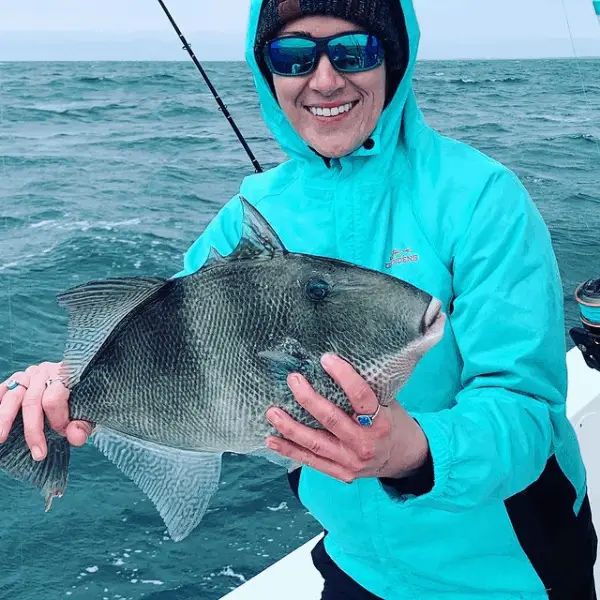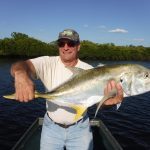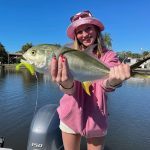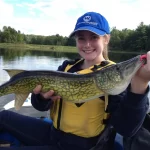Fishing for Triggerfish – Tips, Tackle, and Techniques
The topic of this article will be fishing for triggerfish. Triggerfish are a hard fighting and very tasty species. They are often caught by anglers fishing for other bottom fish. However, they have a devoted following and are targeted specifically by many anglers.
Triggerfish, get their name from the way their dorsal fin will retract when the rear spine is pushed down, or triggered. Most triggerfish caught by anglers in North America are grey triggerfish, or Balistes capriscus. They are an aggressive species that are found along the United States coastline from Texas to the mid Atlantic as well as in the Caribbean Sea.
Triggerfish are quite aggressive compared to many other species. However, that does not mean that they are easy to catch. The primary reason for this is that triggerfish have a very small mouth in relation to their size. This mouth is often compared to a parent with beak like teeth. This allows triggerfish to nibble a bait off without getting hooked.
Triggerfish habits and locations
Triggerfish, like most bottom fish species, almost always relate to structure of some sort. This can be natural hard bottom and coral, ledges, artificial reefs, and wrecks. Triggerfish are rarely found in the inshore bays or passes and inlets. However, they can be found fairly close to shore in many instances, making them an excellent target for anglers with smaller boats.
Smaller ledges and patches of hard bottom that go unnoticed by anglers fishing for grouper and other species are prime spots to target triggerfish. These smaller areas are more difficult to find and to properly position on. However, they will often produce plenty of triggerfish along with snapper and other bottom species. That is one terrific advantage that anglers have when fishing for triggerfish, invariably other species will crash the party.
Best triggerfish fishing tackle
The same tackle that anglers use when bottom fishing for smaller snapper and other species will work fine for triggerfish. Medium spinning tackle and light conventional outfits work very well. Spinning outfits are best and reasonably shallow water where a heavy sinker is not required. Light conventional tackle works best in deeper water or and spots with strong currents where a heavier sinker is needed.
A 7 foot medium action spinning rod with a 3000 to 4000 series reel spooled up with 20 pound braided line is an excellent all round combination for anglers who prefer spinning outfits. A 6 1/2 foot to 7 foot conventional rod with a 2230 series reel and 30 pound braided line works well for anglers who prefer that type of equipment.
Click links to shop Amazon for Penn spinning and conventional outfits
“Fishing Lido Key is a participant in the Amazon Associates Program, an affiliate advertising program designed to provide a means for sites to earn advertising fees by advertising and linking to Amazon. As an Amazon Associate I earn from qualifying purchases. ”
Best hooks and rigs for triggerfish fishing
As mentioned above, triggerfish have a very small mouth. For this reason, they have earned a reputation as being very difficult to catch. In many instances, this is simply because the hooks being used are two large for their smaller mouth. Scaling down and hook size will dramatically increase the catch ratio when targeting triggerfish. These smaller hooks will be fine for snapper and other species as well. Remember, small hooks will catch big fish, but big hooks will rarely catch smaller fish.
Many anglers fishing for triggerfish and other bottom species have gone to circle hooks. In the Gulf of Mexico, they are required. Anglers must use non-stainless steel non-offset circle hooks for any type of reef fishing. Circle hooks dramatically reduce fish mortality as when properly used the hook almost always ends up in the corner of the fishes mouth. For anglers targeting triggerfish, a 2/0 circle hook is an excellent all round size.
For the most part, this is basic, simple bottom fishing. It is hard to beat the tried-and-true high low, or chicken rig. This allows anglers to present a couple different baits at a couple different depths in a vertical presentation. These rigs are available commercially, however most anglers tie their own. Three-way swivels can be used, but simple loop knots with a hook on the end work fine.
Top triggerfish baits
Triggersfish will respond the same baits that produce grouper, snapper, flounder, and other species. Squid is a top bait as it is easily obtained, stays on the hook well, and triggerfish love them. Frozen sardines are another very effective triggerfish bait that is readily available at bait shops. Clams, oysters, and octopus are productive as well.
Small pieces of just about any fresh caught cut bait were great and stay on the hook quite well. Live shrimp produces triggerfish, however is a bit more expensive than some other bait and does not stay on the hook as long.
One popular technique when using the chicken rig is to try a couple of different baits at once. While triggerfish are not notoriously fussy, there are days when one bait will outproduce another. By trying to different baits on the same rig, anglers can quickly identify the bait that fish want that particular day.
Triggerfish fishing techniques
Fishing for triggerfish is not overly complicated. The first order of business is to position the boat over the structure that is to be fished. Anglers can choose to either anchor or drift, depending on the depth, size of the structure, and wind. GPS electric trolling motors have revolutionized bottom fishing as they allow anglers very precise boat control.
The presentation is basically the same when fishing for triggerfish for anglers both anchoring and drifting. Drifting will probably require a bit heavier weight in order to keep the line vertical. This is very important as it both reduces the chances for snags as well as increases hookups.
Once in position, the baits are lower to the bottom. Veteran anglers fishing for triggerfish use heavier weights than might otherwise be needed for a couple of reasons. A heavier weight will maintain the desirable vertical presentation, despite wind and strong currents. Also, the rig falling quickly through the water column to the bottom will virtually eliminate smaller fish nibbling the bait off on the way down.
How to hook triggerfish
As previously mentioned, triggerfish have a reputation for being notoriously difficult to hook. There are a couple of techniques that will help anglers improve their success ratio. One tactic that works well is to very slowly start reeling up the rig as soon as it touches the bottom. This will keep the line tie, taking it easier to feel bites. It will also require the triggerfish to rise up off the bottom to feed on bait that is seemingly escaping.
It is imperative that when fishing for triggerfish (and other species), especially when using circle hooks, to not set the hook when a bite is detected. The best technique is to keep the rod tip low and wait out the little nibbles or taps. Once a steady pull is felt, the angler should real fast tightening up the line and getting the circle hook turning in the fishes mouth. Once hooked, the rod tip can be raised up and the fish reeled in. This technique actually works best when using “J” hooks as well.
Catching triggerfish on the surface
Triggerfish will at times be found feeding on the surface. This will happen naturally when weeds are present. Triggerfish will move up in the water column to feed on forage that is hiding in the weeds. They also respond quite well to chum and will rise up off the bottom into the chum slick to feed.
When triggerfish are encountered on the surface, whether naturally or chummed up, obviously a heavyweight is not desirable. A simple free line rig of a hook and maybe just a split shot or two will be all that is required. Spinning outfits are better than conventional rigs in this application.
Leaders for bottom fishing
In most situations, a 30 pound to 50 pound fluorocarbon leader is the best choice when fishing for triggerfish. They are usually fairly aggressive and willing to bite once located. This is especially true when the water is a bit stirred up and has some color to it. The heavier leader also gives anglers a fighting chance in the event that a larger grouper or other species is.
There will be times when triggerfish will be fussy and reluctant to bite. This can be especially true when the water is clear and the seas are calm. Under these conditions, anglers may enjoy more success by going lighter on the leader as well as the weight. This will also benefit anglers fishing in areas where mangrove snapper are present, which are notoriously line shy in clear water.
Triggerfish are terrific to eat
While triggerfish put up an excellent battle when hooked with the appropriate tackle, they are mostly prized for their incredibly tasty snow white fillets. Triggerfish are fantastic eating! With their increased popularity has come more regulations. Anglers need to check their local regulations, keeping in mind that they are often different for state and federal waters.
One downside to keeping triggerfish to eat is that they are fairly difficult to clean. Triggerfish half incredibly tough skin and a sharp knife is required. They also have fairly large rib cages and bones. Finally, the fillet is not huge in relation to the fishes size. However, all of this work is worth it once the triggerfish is properly prepared and served on a plate.
In conclusion, this article on fishing for triggerfish will help a






